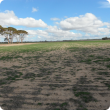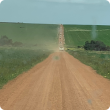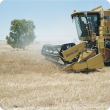Crops
The Department of Primary Industries and Regional Development continues to support the growth and international competitiveness of all crop industries in Western Australia.
With a 2400 kilometre span from its tropical north to its temperate south, WA supports a broad range of cropping industries from rain-fed winter cereals through to irrigated horticultural crops.
In the 2012/13 year the WA cropping industries exported a total of $3.9 billion which comprised: $3.1 billion of cereals, $859 million of pulses, pastures and oilseeds, $142 million of horticultural crops. The major contributors to these exports were wheat ($2.7 billion), canola ($756 million), barley ($377 million), lupins ($42 million), carrots at $48 million, oats ($12 million), and strawberries at $5.5 million.
Filter by search
Filter by topic
- (-) Remove Pasture management filter Pasture management
- (-) Remove Pastures filter Pastures
- Livestock & animals (18) Apply Livestock & animals filter
- Livestock species (16) Apply Livestock species filter
- Pasture species (11) Apply Pasture species filter
- Livestock management (11) Apply Livestock management filter
- Climate, land & water (11) Apply Climate, land & water filter
- Pests, weeds & diseases (8) Apply Pests, weeds & diseases filter
- Soils (7) Apply Soils filter
- Sheep (7) Apply Sheep filter
- Dairy cattle (7) Apply Dairy cattle filter
- Managing soils (7) Apply Managing soils filter
- Grains (6) Apply Grains filter
- Feeding & nutrition (6) Apply Feeding & nutrition filter
- Weeds (5) Apply Weeds filter
- Soil nutrients (5) Apply Soil nutrients filter
- Pasture establishment (5) Apply Pasture establishment filter
- Crop weeds (5) Apply Crop weeds filter
- Grains research & development (4) Apply Grains research & development filter
- Livestock research & development (3) Apply Livestock research & development filter
- Irrigated crops (3) Apply Irrigated crops filter
- Vegetables (2) Apply Vegetables filter
- Lupins (2) Apply Lupins filter
- Soil acidity (2) Apply Soil acidity filter
- Water (2) Apply Water filter
- Wheat (2) Apply Wheat filter
- Water management (2) Apply Water management filter
- Horticulture (2) Apply Horticulture filter
- Crop diseases (2) Apply Crop diseases filter
- Grapes & wine (2) Apply Grapes & wine filter
- Beef cattle (2) Apply Beef cattle filter
- Control methods (2) Apply Control methods filter
- Climate & weather (2) Apply Climate & weather filter
- Diseases (2) Apply Diseases filter
- Fruit (2) Apply Fruit filter
- Land use (1) Apply Land use filter
- High rainfall pastures (1) Apply High rainfall pastures filter
- Irrigation (1) Apply Irrigation filter
- Nursery & cutflowers (1) Apply Nursery & cutflowers filter
- Herbicides (1) Apply Herbicides filter
- Measuring and assessing soils (1) Apply Measuring and assessing soils filter
- Management & reproduction (1) Apply Management & reproduction filter
- Canola (1) Apply Canola filter
- Biosecurity (1) Apply Biosecurity filter
- Barley (1) Apply Barley filter
- Biosecurity & quarantine (1) Apply Biosecurity & quarantine filter
- Chemicals (1) Apply Chemicals filter
- Dry seasons and drought (1) Apply Dry seasons and drought filter
- Fire (1) Apply Fire filter












